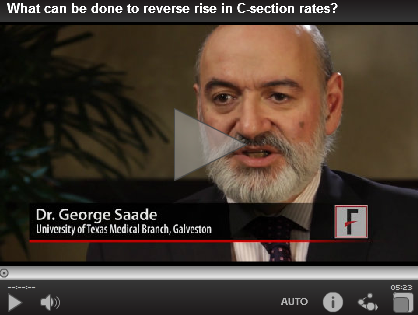User login
NEW ORLEANS – The rate of cesarean section in the United States has risen dramatically in the past 2 decades, accounting for 30% of all deliveries in 2011.
Several factors are driving the increase, according to the Society for Maternal-Fetal Medicine, which sponsored the annual Pregnancy Meeting. Women are waiting until later in life to have children, and their obesity rates are higher than ever before – both of which increase the risk of medical complications during pregnancy. Fear of malpractice also motivates some ob.gyns. to rely on C-sections.
But the most common reason for a woman to have a C-section is that she has had one before, explained Dr. George Saade, director of the division of maternal-fetal medicine at the University of Texas Medical Branch, Galveston. In a video interview, Dr. Saade discussed what’s fueling the rise, and what physicians must do to reduce C-section rates.
The video associated with this article is no longer available on this site. Please view all of our videos on the MDedge YouTube channel
NEW ORLEANS – The rate of cesarean section in the United States has risen dramatically in the past 2 decades, accounting for 30% of all deliveries in 2011.
Several factors are driving the increase, according to the Society for Maternal-Fetal Medicine, which sponsored the annual Pregnancy Meeting. Women are waiting until later in life to have children, and their obesity rates are higher than ever before – both of which increase the risk of medical complications during pregnancy. Fear of malpractice also motivates some ob.gyns. to rely on C-sections.
But the most common reason for a woman to have a C-section is that she has had one before, explained Dr. George Saade, director of the division of maternal-fetal medicine at the University of Texas Medical Branch, Galveston. In a video interview, Dr. Saade discussed what’s fueling the rise, and what physicians must do to reduce C-section rates.
The video associated with this article is no longer available on this site. Please view all of our videos on the MDedge YouTube channel
NEW ORLEANS – The rate of cesarean section in the United States has risen dramatically in the past 2 decades, accounting for 30% of all deliveries in 2011.
Several factors are driving the increase, according to the Society for Maternal-Fetal Medicine, which sponsored the annual Pregnancy Meeting. Women are waiting until later in life to have children, and their obesity rates are higher than ever before – both of which increase the risk of medical complications during pregnancy. Fear of malpractice also motivates some ob.gyns. to rely on C-sections.
But the most common reason for a woman to have a C-section is that she has had one before, explained Dr. George Saade, director of the division of maternal-fetal medicine at the University of Texas Medical Branch, Galveston. In a video interview, Dr. Saade discussed what’s fueling the rise, and what physicians must do to reduce C-section rates.
The video associated with this article is no longer available on this site. Please view all of our videos on the MDedge YouTube channel
AT THE PREGNANCY MEETING
